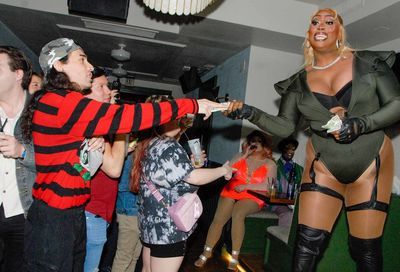Defying Convention: The Art of Romaine Brooks
A powerful new exhibit celebrates lesbian artist Romaine Brooks, who painted against the grain of her time, with women often dressed in ambiguously masculine garb

Joe Lucchesi remembers the first time he happened upon a painting by Romaine Brooks.
“I was walking through the galleries during my summer internship and I was like, ‘What is that?‘” says the curator of The Art of Romaine Brooks, currently at the Smithsonian’s American Art Museum. “I had no idea who she was. I had never seen anything like it.” The painting was Brooks’ Self-Portrait, 1923, part of the museum’s permanent collection.
Even Cassandra Langer, widely considered the expert on Brooks and the author of Romaine Brooks: A Life, had a similarly chance introduction. She calls herself the artist’s “accidental biographer” because she inadvertently noticed the same self-portrait while a graduate student.
“I had been sent to review a Vito Acconci show,” Langer recalls. “The elevator doors opened on the second floor, and across the room, I saw her self-portrait. It was so compelling that it absolutely made me stop, forget about Vito Acconci, walk across the room and encounter Romaine Brooks for the first time.”
This was in the ’70s, a decade before Brooks achieved cult status and became “a lesbian role model,” says Langer. Brooks’ notoriety developed largely on account of the way she presented women in her portraits — affirmatively, well-tailored, independent subjects, rather than skimpily attired objects for the male gaze. Her works play with gender and sexuality in a way familiar today but unprecedented a century ago. The artist lived and loved as a lesbian, but didn’t publicly acknowledge it.
She was ahead of her time in many ways, but it is only recently that her sexuality has been considered worthy of further study. Predecessors in the field strongly discouraged Langer from pursuing what, in the end, has become her signature area of expertise. “It’s been a difficult journey,” she says, “because people have used her lesbianism as a pejorative rather than as something to be celebrated.”

In her early days as a teacher at Florida International University, Langer came face-to-face with the opposition her work had encouraged. “I had to have the Civil Liberties Union with me when I gave my first lecture on Romaine Brooks, because I was going to be accused of moral turpitude for dealing with lesbian/queer subjects.”
Yet there could be no denying Brooks’ sexuality. “As a lesbian, I knew immediately I was looking at a lesbian subject,” she says. “There was no anything about it. It was so arresting. To have a lesbian subject who was not a pathetic-looking, suicidal person because of being a lesbian, was a revelation. Here I was looking at this portrait who was gazing out at me in a sort of cruisy, sardonic way, and I thought, ‘I don’t know anything about this painter.'”
The Art of Romaine Brooks isn’t likely to stoke any controversy, despite its lesbian undertones, because Brooks’ work isn’t incendiary or suggestive. It can take more than one viewing to truly comprehend her work, and it might not seem as provocative and groundbreaking as it once did. But Langer believes Brooks deserves to be considered “in the pantheon of American artists,” on par with her fellow expatriates in Europe, including James McNeill Whistler, John Singer Sargent, and Mary Cassatt. “She can be credited as the first surrealist, long before the term was invented,” Langer says, citing drawings by Brooks that explore psychology and “her own subconscious.”
Langer also notes that, unlike her contemporary Cassatt, with “her little pastel figures and her maternity,” Brooks’ paintings buck feminine convention by being relatively austere, big in scale and bold in style. She presents confident, often stern-looking women in individual poses, and paints them largely using blacks, whites and shades of grey, color “generally identified with the male.” Brooks had a long-term relationship with Natalie Barney and Elisabeth de Gramont, a polyamorous “family of choice” that Langer calls “particularly original and audacious, setting a standard that I would say many contemporary men and women have adopted.”

Though the focus is on only one artist, Lucchesi considers The Art of Romaine Brooks a natural successor to Hide/Seek, the controversial showing of LGBT art at the National Portrait Gallery six years ago. The exhibit sheds light on a lesbian artist who doesn’t flinch from addressing LGBT themes and “visual queerness” in her work — from lesbian presentation to gender fluidity. Increased transgender awareness in just the past few years has also helped make the show quite different than an exhibit on Brooks that Lucchesi curated in 2000, at the National Museum of Women in the Arts.
“One thing I’m very interested in is how much the Brooks show seems to plug into trans issues,” says Lucchesi. “[It offers] a new context for thinking about visual queerness and trans issues and gender fluidity. There is an aspect of the work that connects to those ideas.
“One of the reasons that I am able to come back to Romaine Brooks over such a long period of time is that that is the kind of work that I like,” he continues. “It was challenging to its viewers in some regard when it was out, it’s challenging to think about now. It’s got a lot of angles to it. It’s beautiful.”
METRO WEEKLY: Did Romaine Brooks ever openly call herself lesbian, or fully acknowledge her female relationships?
JOE LUCCHESI: She did privately. But no, she never made any kind of public declaration. She wasn’t out necessarily in a conventional sense. To me, this has always been one of the things that’s most interesting about her work, because it makes some pretty strong statements. But it also doesn’t necessarily constitute a kind of coming out, if you will, or of a public declaration of being a lesbian or being queer.

MW: Given she doesn’t shout about her sexuality in her art, has there been any controversy over framing Brook’s work from a lesbian standpoint?
LUCCHESI: Around the time of my show at the National Museum of Women in the Arts, there was an article written by Meryle Secrest, the first biographer of Romaine Brooks. She more or less said, “Oh my God, if she saw this show, she’d be rolling over in her grave because this work is not about that. It’s about her. It’s about all these other things and to reduce it” — I think that’s the language that she used — “to being about her sexuality would be a complete insult to her.” One of the reviewers from the Washington Post responded to that, and said, “Look, we’re basically saying that the work, in all these ways, is inherently tied up with her sense of self. And part of that sense of self was a very strong identification with a series of queer communities.”
You hear the term modern art so associated with the formal experimentation of the whole Picasso/Matisse crowd. And that’s fine, but Brooks was literally living in their neighborhood doing something profoundly different that could easily be considered modern. I think the need to not have to explain or justify the relationship between her sexuality and her work really opens up a space for thinking about the importance of her work in other ways.
MW: You first discovered Brooks as a summer intern at the Smithsonian American Art Museum. Did that spark your academic interest in LGBT art in general?
LUCCHESI: I saw that in my first year of grad school, and basically filed it away. This was when LGBT and queer studies had really gained some steam in art historical scholarship. And so I always had that painting stuck in my head. I made a decision in grad school that LGBT and queer issues was the way I was going to go. I began thinking through projects and issues and what I could do with that work. So it’s been a while. She’s been with me for 25 years now.
MW: Have you ever been discouraged from focusing on Brooks or on LGBT art?
LUCCHESI: Yes and no. I think I benefited from some of the resistance that Sandy Langer and other earlier scholars encountered. It took a while to wear down and really begin to incorporate queer perspectives in art history. And a lot of that came directly from feminist efforts both inside and outside the discipline. I don’t think I got the amount of resistance that Sandy did, but I encountered pockets of discouragement from particular professors or others out in the field in general. I think that’s very different now.
From my own experience, the difference between the level of even vague recognition of who she is, is so different from 16 years ago, when she really was a fairly obscure, niche artist. I wouldn’t say that about her now. There has been enough of a sustained effort to bring her into greater prominence. She’s in at least one of the textbooks now, which I thought was a great barrier to have crossed. And I definitely think this show, just because of where it is and its attachment to the Smithsonian as a whole, is just going to keep that effort moving forward, to put her where she belongs as far as I’m concerned.

MW: Is she identified as a lesbian artist in that textbook?
LUCCHESI: She is. It’s also sort of framed around the idea of her as an expatriate, which, of course, is completely the right way to do it. She’s in there with other expatriates like Whistler and Sargent and Mary Cassatt, who were all Americans living abroad. There are all kinds of reasons that they lived abroad. You can see and understand their work through that lens.
MW: Why were so many artists drawn to live abroad, particularly Europe?
LUCCHESI: Insert whatever freedom is most appropriate to any one of those people — aesthetically, or because of gender, because of sexuality or because of class, I mean just anything. American expats congregated with each other to create communities, particularly in Paris, because they didn’t have them in the places they came from. It’s very interesting, the physical geography of how close Romaine and Natalie Barney lived to Gertrude Stein and Alice Toklas. They were literally two blocks away from each other, building these salons and this mostly expatriate culture, both with queer inflections, certainly Natalie Barney more than Gertrude Stein. It was such a vibrant, exciting culture to be a part of. And those networks were really, really critical to all of them.
MW: Can you think of other LGBT artists who would merit a prominent exhibit similar to this?
LUCCHESI: I will always go back to Hide/Seek. I feel like part of the work that show did was say, “Why don’t you do more on this?” “Here is somebody else.” It put so much out there for people to build on. It’s a little bit of a cop out of an answer, but I would point to almost anybody in that show as somebody who deserves what’s happening to Romaine right now.

MW: The masculine presentation of Brooks and other women can now be seen as a marker of transgender identity.
LUCCHESI: Absolutely, that’s right. Think about those women who were presenting themselves and dressing those ways — they were doing it strategically. I think that strategic ambiguity and fluidity is the thing that most resonates with me in some of the ways that trans folks talk about themselves: “This is who I am. You’re the one that’s reading all this. You’re the one that’s doing all the decoding. This is just me.” When I go through the show with friends, it’s interesting how different people describe what they’re looking at, particularly in the gender ambiguous portraits.
MW: In 50 years time, is it possible people will be viewing Brooks’s work differently?
LUCCHESI: I think some future art historian is going to look back on it and be like, “Wow, that’s all you thought?” There are certain ways that even my own arguments could be completely reshaped by somebody with a different perspective in the future. I certainly do that to other art historians. I would be thrilled if things moved in such a direction that even my own stuff seemed dated or too simplistic. That would be great. All art historical scholarship is a time capsule of where you are at that moment. And things change. One of the cool things is being able to look back and see how they changed.
MW: Brooks used coded masculine imagery and ambiguous self-presentation, but as far as we know she didn’t identify as transgender?
LUCCHESI: No, not at all. In her self-portrait from 1923 and Una Troubridge’s portrait, they’re not even wearing pants. I think she leaves it purposely unclear what they’re wearing. But in her real life, Romaine Brooks was a total clotheshorse. And I mean female designer clotheshorse. Of the portraits that are in the show, the only one who really wore outwardly men’s clothes was Gluck, or as she’s called in the show, Peter. All of the other sitters are wearing things that may be masculinely tailored and are certainly flirting with a kind of presentation as masculine, but Brooks was very secure in who she was as a female-bodied person. When I read all of her correspondence, particularly with Natalie Barney, it’s amazing how much she seems typical as a wealthy woman of her time. She thinks about clothes in ways that are interesting and maybe a little edgy, but very in line with tastes of her time.

MW: Would you say the exhibit focuses more on Brooks’ identity as someone with obvious lesbian affinities than the one you curated in 2000?
LUCCHESI: It does. To be honest, that’s deliberate on my part. It is also driven by the work that’s in the show, which skews a little bit later in her career. That’s where she’s engaging with lots of issues of gender and sexuality and has found her aesthetic voice. She’s doing some really interesting things in that slightly later work. Because it’s shifted towards a slightly more mature voice, I think that it engages those issues a bit more fully, or they’re closer to the surface.
The show is interesting because it’s the Smithsonian’s collection — all work given to them directly by Romaine Brooks. I’ve always thought that the work seems very carefully chosen by her, as if it’s how she wanted to be represented.
The Art of Romaine Brooks runs through Oct. 2 at the Smithsonian American Art Museum, 8th and F Streets NW. Call 202-633-1000 or visit americanart.si.edu.
Support Metro Weekly’s Journalism
These are challenging times for news organizations. And yet it’s crucial we stay active and provide vital resources and information to both our local readers and the world. So won’t you please take a moment and consider supporting Metro Weekly with a membership? For as little as $5 a month, you can help ensure Metro Weekly magazine and MetroWeekly.com remain free, viable resources as we provide the best, most diverse, culturally-resonant LGBTQ coverage in both the D.C. region and around the world. Memberships come with exclusive perks and discounts, your own personal digital delivery of each week’s magazine (and an archive), access to our Member's Lounge when it launches this fall, and exclusive members-only items like Metro Weekly Membership Mugs and Tote Bags! Check out all our membership levels here and please join us today!

























